
Question Number 2874 by RasheedAhmad last updated on 29/Nov/15
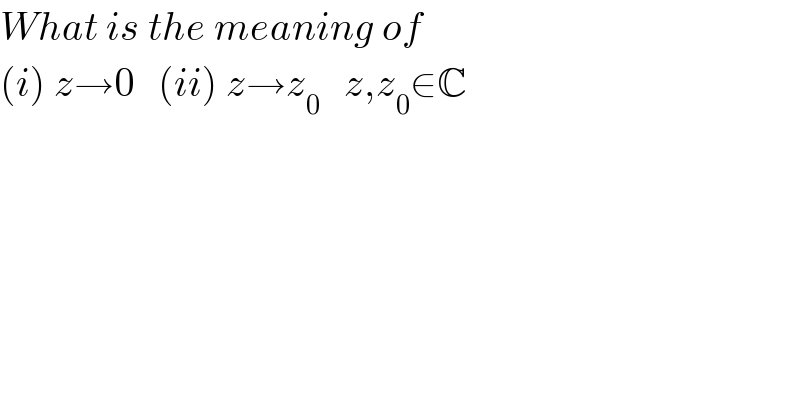
$${What}\:{is}\:{the}\:{meaning}\:{of} \\ $$$$\left({i}\right)\:{z}\rightarrow\mathrm{0}\:\:\:\left({ii}\right)\:{z}\rightarrow{z}_{\mathrm{0}} \:\:\:{z},{z}_{\mathrm{0}} \in\mathbb{C} \\ $$
Answered by Filup last updated on 29/Nov/15
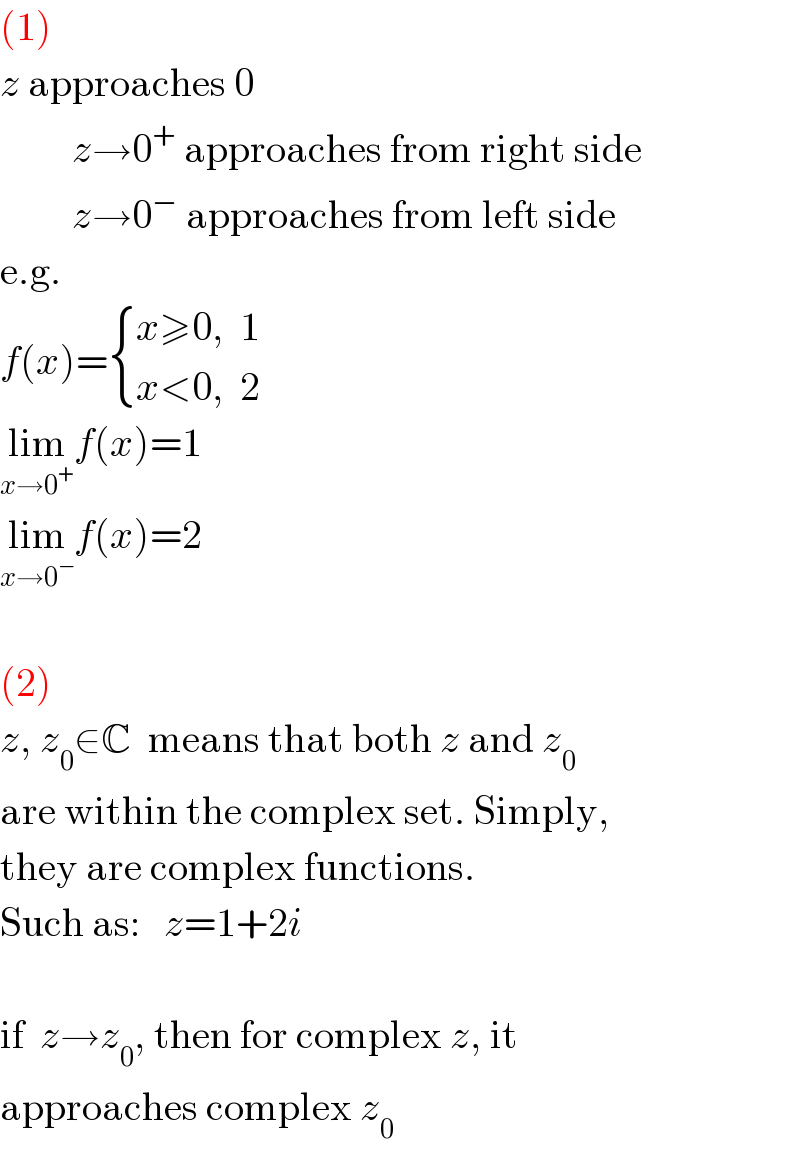
$$\left(\mathrm{1}\right) \\ $$$${z}\:\mathrm{approaches}\:\mathrm{0} \\ $$$$\:\:\:\:\:\:\:\:\:{z}\rightarrow\mathrm{0}^{+} \:\mathrm{approaches}\:\mathrm{from}\:\mathrm{right}\:\mathrm{side} \\ $$$$\:\:\:\:\:\:\:\:\:{z}\rightarrow\mathrm{0}^{−} \:\mathrm{approaches}\:\mathrm{from}\:\mathrm{left}\:\mathrm{side} \\ $$$$\mathrm{e}.\mathrm{g}. \\ $$$${f}\left({x}\right)=\begin{cases}{{x}\geqslant\mathrm{0},\:\:\mathrm{1}}\\{{x}<\mathrm{0},\:\:\mathrm{2}}\end{cases} \\ $$$$\underset{{x}\rightarrow\mathrm{0}^{+} } {\mathrm{lim}}{f}\left({x}\right)=\mathrm{1} \\ $$$$\underset{{x}\rightarrow\mathrm{0}^{−} } {\mathrm{lim}}{f}\left({x}\right)=\mathrm{2} \\ $$$$ \\ $$$$\left(\mathrm{2}\right) \\ $$$${z},\:{z}_{\mathrm{0}} \in\mathbb{C}\:\:\mathrm{means}\:\mathrm{that}\:\mathrm{both}\:{z}\:\mathrm{and}\:{z}_{\mathrm{0}} \\ $$$$\mathrm{are}\:\mathrm{within}\:\mathrm{the}\:\mathrm{complex}\:\mathrm{set}.\:\mathrm{Simply}, \\ $$$$\mathrm{they}\:\mathrm{are}\:\mathrm{complex}\:\mathrm{functions}. \\ $$$$\mathrm{Such}\:\mathrm{as}:\:\:\:{z}=\mathrm{1}+\mathrm{2}{i} \\ $$$$ \\ $$$$\mathrm{if}\:\:{z}\rightarrow{z}_{\mathrm{0}} ,\:\mathrm{then}\:\mathrm{for}\:\mathrm{complex}\:{z},\:\mathrm{it}\: \\ $$$$\mathrm{approaches}\:\mathrm{complex}\:{z}_{\mathrm{0}} \\ $$
Answered by Yozzi last updated on 29/Nov/15
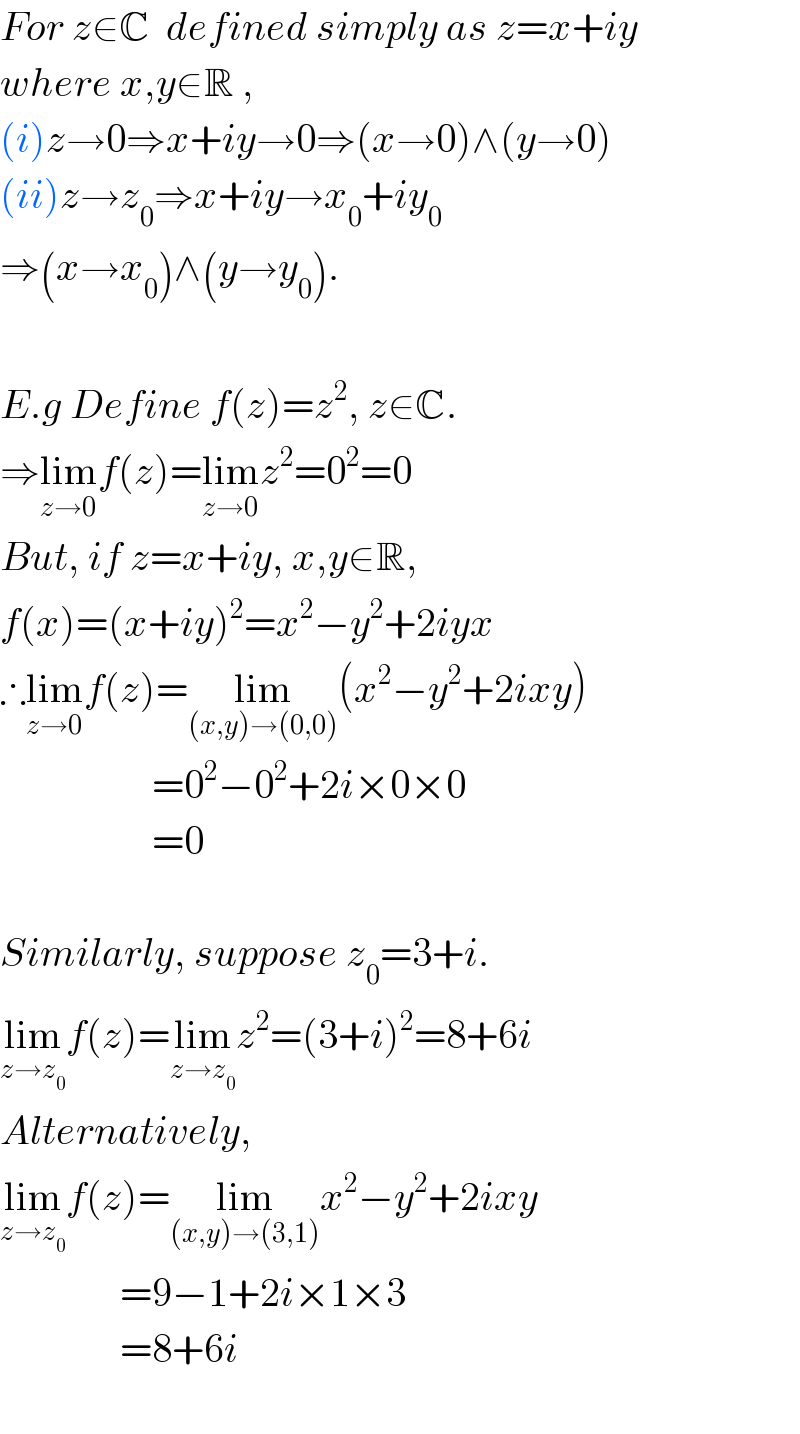
$${For}\:{z}\in\mathbb{C}\:\:{defined}\:{simply}\:{as}\:{z}={x}+{iy} \\ $$$${where}\:{x},{y}\in\mathbb{R}\:, \\ $$$$\left({i}\right){z}\rightarrow\mathrm{0}\Rightarrow{x}+{iy}\rightarrow\mathrm{0}\Rightarrow\left({x}\rightarrow\mathrm{0}\right)\wedge\left({y}\rightarrow\mathrm{0}\right) \\ $$$$\left({ii}\right){z}\rightarrow{z}_{\mathrm{0}} \Rightarrow{x}+{iy}\rightarrow{x}_{\mathrm{0}} +{iy}_{\mathrm{0}} \\ $$$$\Rightarrow\left({x}\rightarrow{x}_{\mathrm{0}} \right)\wedge\left({y}\rightarrow{y}_{\mathrm{0}} \right). \\ $$$$ \\ $$$${E}.{g}\:{Define}\:{f}\left({z}\right)={z}^{\mathrm{2}} ,\:{z}\in\mathbb{C}. \\ $$$$\Rightarrow\underset{{z}\rightarrow\mathrm{0}} {\mathrm{lim}}{f}\left({z}\right)=\underset{{z}\rightarrow\mathrm{0}} {\mathrm{lim}}{z}^{\mathrm{2}} =\mathrm{0}^{\mathrm{2}} =\mathrm{0} \\ $$$${But},\:{if}\:{z}={x}+{iy},\:{x},{y}\in\mathbb{R}, \\ $$$${f}\left({x}\right)=\left({x}+{iy}\right)^{\mathrm{2}} ={x}^{\mathrm{2}} −{y}^{\mathrm{2}} +\mathrm{2}{iyx} \\ $$$$\therefore\underset{{z}\rightarrow\mathrm{0}} {\mathrm{lim}}{f}\left({z}\right)=\underset{\left({x},{y}\right)\rightarrow\left(\mathrm{0},\mathrm{0}\right)} {\mathrm{lim}}\left({x}^{\mathrm{2}} −{y}^{\mathrm{2}} +\mathrm{2}{ixy}\right) \\ $$$$\:\:\:\:\:\:\:\:\:\:\:\:\:\:\:\:\:\:\:=\mathrm{0}^{\mathrm{2}} −\mathrm{0}^{\mathrm{2}} +\mathrm{2}{i}×\mathrm{0}×\mathrm{0} \\ $$$$\:\:\:\:\:\:\:\:\:\:\:\:\:\:\:\:\:\:\:=\mathrm{0} \\ $$$$ \\ $$$${Similarly},\:{suppose}\:{z}_{\mathrm{0}} =\mathrm{3}+{i}. \\ $$$$\underset{{z}\rightarrow{z}_{\mathrm{0}} } {\mathrm{lim}}{f}\left({z}\right)=\underset{{z}\rightarrow{z}_{\mathrm{0}} } {\mathrm{lim}}{z}^{\mathrm{2}} =\left(\mathrm{3}+{i}\right)^{\mathrm{2}} =\mathrm{8}+\mathrm{6}{i} \\ $$$${Alternatively}, \\ $$$$\underset{{z}\rightarrow{z}_{\mathrm{0}} } {\mathrm{lim}}{f}\left({z}\right)=\underset{\left({x},{y}\right)\rightarrow\left(\mathrm{3},\mathrm{1}\right)} {\mathrm{lim}}{x}^{\mathrm{2}} −{y}^{\mathrm{2}} +\mathrm{2}{ixy} \\ $$$$\:\:\:\:\:\:\:\:\:\:\:\:\:\:\:=\mathrm{9}−\mathrm{1}+\mathrm{2}{i}×\mathrm{1}×\mathrm{3} \\ $$$$\:\:\:\:\:\:\:\:\:\:\:\:\:\:\:=\mathrm{8}+\mathrm{6}{i} \\ $$$$ \\ $$
Commented by Yozzi last updated on 29/Nov/15

$${I}\:{see}.\:{Thanks}! \\ $$
Commented by 123456 last updated on 29/Nov/15
![however there infinite ways to aproach z_0 on C, so if the limit depends on path that you taked, them it doenst exist [like in the R, lim_(x→0^− ) f(x)≠lim_(x→0^+ ) f(x),lim_(x→0) f(x)=∄]](Q2883.png)
$$\mathrm{however}\:\mathrm{there}\:\mathrm{infinite}\:\mathrm{ways}\:\mathrm{to}\:\mathrm{aproach} \\ $$$${z}_{\mathrm{0}} \:\mathrm{on}\:\mathbb{C},\:\mathrm{so}\:\mathrm{if}\:\mathrm{the}\:\mathrm{limit}\:\mathrm{depends}\:\mathrm{on}\:\mathrm{path} \\ $$$$\mathrm{that}\:\mathrm{you}\:\mathrm{taked},\:\mathrm{them}\:\mathrm{it}\:\mathrm{doenst}\:\mathrm{exist} \\ $$$$\left[\mathrm{like}\:\mathrm{in}\:\mathrm{the}\:\mathbb{R},\:\underset{{x}\rightarrow\mathrm{0}^{−} } {\mathrm{lim}}{f}\left({x}\right)\neq\underset{{x}\rightarrow\mathrm{0}^{+} } {\mathrm{lim}}{f}\left({x}\right),\underset{{x}\rightarrow\mathrm{0}} {\mathrm{lim}}{f}\left({x}\right)=\nexists\right] \\ $$
Commented by prakash jain last updated on 29/Nov/15
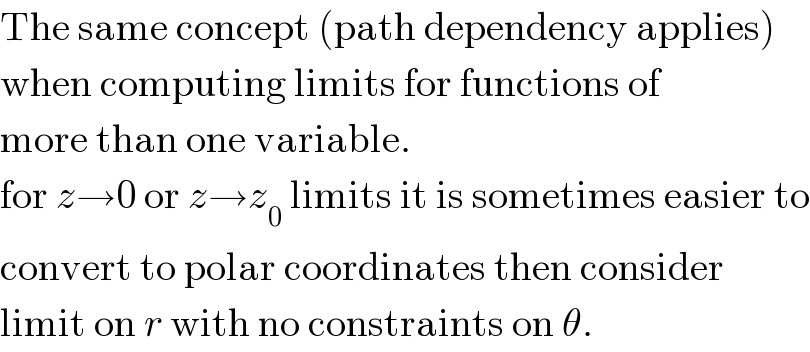
$$\mathrm{The}\:\mathrm{same}\:\mathrm{concept}\:\left(\mathrm{path}\:\mathrm{dependency}\:\mathrm{applies}\right) \\ $$$$\mathrm{when}\:\mathrm{computing}\:\mathrm{limits}\:\mathrm{for}\:\mathrm{functions}\:\mathrm{of} \\ $$$$\mathrm{more}\:\mathrm{than}\:\mathrm{one}\:\mathrm{variable}. \\ $$$$\mathrm{for}\:{z}\rightarrow\mathrm{0}\:\mathrm{or}\:{z}\rightarrow{z}_{\mathrm{0}} \:\mathrm{limits}\:\mathrm{it}\:\mathrm{is}\:\mathrm{sometimes}\:\mathrm{easier}\:\mathrm{to} \\ $$$$\mathrm{convert}\:\mathrm{to}\:\mathrm{polar}\:\mathrm{coordinates}\:\mathrm{then}\:\mathrm{consider} \\ $$$$\mathrm{limit}\:\mathrm{on}\:{r}\:\mathrm{with}\:\mathrm{no}\:\mathrm{constraints}\:\mathrm{on}\:\theta. \\ $$
Commented by Rasheed Soomro last updated on 29/Nov/15

$${What}\:{are}\:{other}\:{ways},\:{for}\:{example},\:{of}\:{approaching}\:{z}_{\mathrm{0}} \\ $$$${and}\:{what}\:{is}\:'{path}\:{dependancy}'? \\ $$
Commented by 123456 last updated on 29/Nov/15
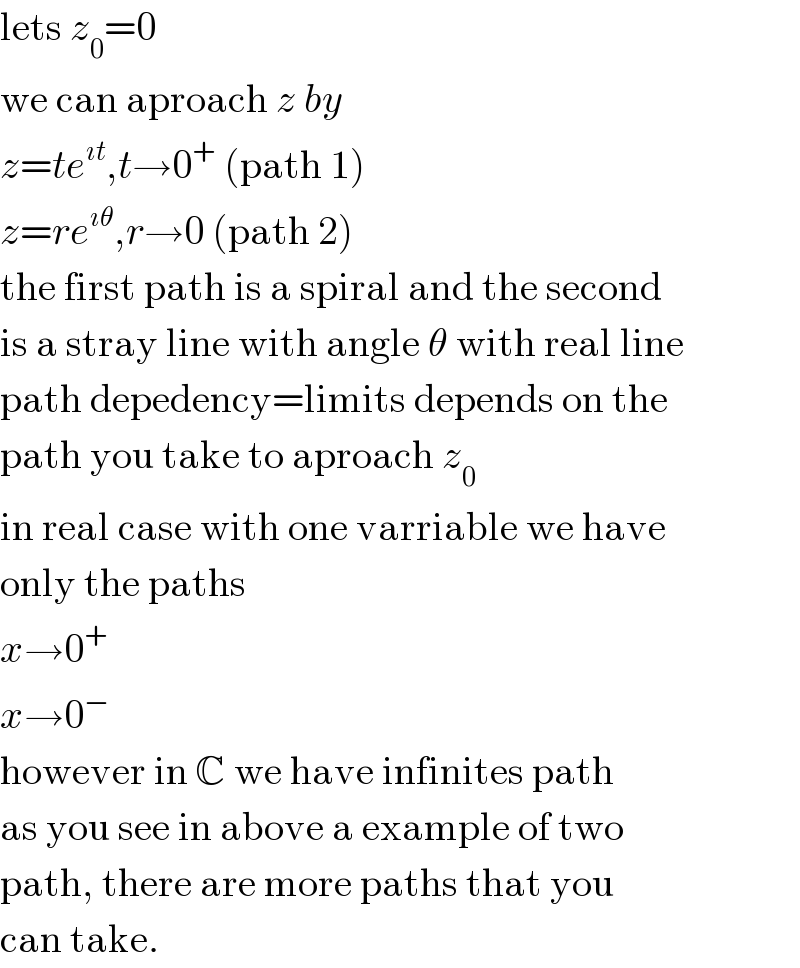
$$\mathrm{lets}\:{z}_{\mathrm{0}} =\mathrm{0} \\ $$$$\mathrm{we}\:\mathrm{can}\:\mathrm{aproach}\:{z}\:{by} \\ $$$${z}={te}^{\imath{t}} ,{t}\rightarrow\mathrm{0}^{+} \:\left(\mathrm{path}\:\mathrm{1}\right)\:\: \\ $$$${z}={re}^{\imath\theta} ,{r}\rightarrow\mathrm{0}\:\left(\mathrm{path}\:\mathrm{2}\right) \\ $$$$\mathrm{the}\:\mathrm{first}\:\mathrm{path}\:\mathrm{is}\:\mathrm{a}\:\mathrm{spiral}\:\mathrm{and}\:\mathrm{the}\:\mathrm{second} \\ $$$$\mathrm{is}\:\mathrm{a}\:\mathrm{stray}\:\mathrm{line}\:\mathrm{with}\:\mathrm{angle}\:\theta\:\mathrm{with}\:\mathrm{real}\:\mathrm{line} \\ $$$$\mathrm{path}\:\mathrm{depedency}=\mathrm{limits}\:\mathrm{depends}\:\mathrm{on}\:\mathrm{the} \\ $$$$\mathrm{path}\:\mathrm{you}\:\mathrm{take}\:\mathrm{to}\:\mathrm{aproach}\:{z}_{\mathrm{0}} \\ $$$$\mathrm{in}\:\mathrm{real}\:\mathrm{case}\:\mathrm{with}\:\mathrm{one}\:\mathrm{varriable}\:\mathrm{we}\:\mathrm{have} \\ $$$$\mathrm{only}\:\mathrm{the}\:\mathrm{paths} \\ $$$${x}\rightarrow\mathrm{0}^{+} \\ $$$${x}\rightarrow\mathrm{0}^{−} \\ $$$$\mathrm{however}\:\mathrm{in}\:\mathbb{C}\:\mathrm{we}\:\mathrm{have}\:\mathrm{infinites}\:\mathrm{path} \\ $$$$\mathrm{as}\:\mathrm{you}\:\mathrm{see}\:\mathrm{in}\:\mathrm{above}\:\mathrm{a}\:\mathrm{example}\:\mathrm{of}\:\mathrm{two} \\ $$$$\mathrm{path},\:\mathrm{there}\:\mathrm{are}\:\mathrm{more}\:\mathrm{paths}\:\mathrm{that}\:\mathrm{you} \\ $$$$\mathrm{can}\:\mathrm{take}. \\ $$
Commented by Rasheed Soomro last updated on 29/Nov/15

$$\mathcal{T}\:\mathcal{HANK}^{\mathcal{S}\boldsymbol{{s}}{s}} \:\boldsymbol{{for}}\:\boldsymbol{{all}}\:\boldsymbol{{of}}\:\boldsymbol{\mathcal{Y}}\mathcal{OU}\:! \\ $$$$\mathcal{I}\:{always}\:{have}\:{learnt}\:{from}\:{you}. \\ $$
